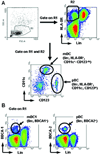Human dendritic cells and transplant outcome
- PMID: 18551047
- PMCID: PMC3780572
- DOI: 10.1097/TP.0b013e318173a768
Human dendritic cells and transplant outcome
Abstract
Early interest in dendritic cells (DC) in transplantation centered on the role of graft interstitial DC in the instigation of rejection. Much information has subsequently accumulated concerning the phenotypic and functional diversity of these rare, migratory, bone marrow-derived antigen-presenting cells, and their role in the induction and regulation of immunity. Detailed insights have emerged from studies of freshly isolated or in vitro-propagated DC, and from analyses of their function in experimental animal models. The functional plasticity of these uniquely well-equipped antigen-presenting cells is reflected in their ability not only to induce alloimmune responses, but also to serve as potential targets and therapeutic agents for the long-term improvement of transplant outcome. Notably, however, a great deal remains to be understood about the immunobiology of DC populations in relation to human transplant outcome. Herein, we briefly review aspects of human DC biology in organ and bone marrow transplantation, the potential of these cells for monitoring outcome, and the role of DC in development of vaccines to protect against infectious disease or to promote allograft tolerance.
Figures

Similar articles
-
Preferential induction of Th1 responses by functionally mature hepatic (CD8alpha- and CD8alpha+) dendritic cells: association with conversion from liver transplant tolerance to acute rejection.Transplantation. 2000 Jun 27;69(12):2647-57. doi: 10.1097/00007890-200006270-00027. Transplantation. 2000. PMID: 10910289
-
Impact of Flt-3 ligand on donor-derived antigen presenting cells and alloimmune reactivity in heart graft recipients given adjuvant donor bone marrow.Transpl Immunol. 1998 Dec;6(4):225-34. doi: 10.1016/s0966-3274(98)80012-9. Transpl Immunol. 1998. PMID: 10342736
-
Dendritic cells,tolerance and therapy of organ allograft rejection.Contrib Nephrol. 2005;146:105-120. doi: 10.1159/000082071. Contrib Nephrol. 2005. PMID: 15567925 Review.
-
Donor bone marrow potentiates the effect of tacrolimus on nonvascularized heart allograft survival: association with microchimerism and growth of donor dendritic cell progenitors from recipient bone marrow.Transplantation. 1998 Feb 27;65(4):479-85. doi: 10.1097/00007890-199802270-00005. Transplantation. 1998. PMID: 9500620
-
Tolerogenic Dendritic Cells: The Pearl of Immunotherapy in Organ Transplantation.Front Immunol. 2020 Oct 6;11:552988. doi: 10.3389/fimmu.2020.552988. eCollection 2020. Front Immunol. 2020. PMID: 33123131 Free PMC article. Review.
Cited by
-
Regulatory myeloid cells in transplantation.Transplantation. 2014 Feb 27;97(4):367-79. doi: 10.1097/TP.0b013e3182a860de. Transplantation. 2014. PMID: 24092382 Free PMC article. Review.
-
Dendritic cell populations with different concentrations of lipid regulate tolerance and immunity in mouse and human liver.Gastroenterology. 2012 Oct;143(4):1061-72. doi: 10.1053/j.gastro.2012.06.003. Epub 2012 Jun 12. Gastroenterology. 2012. PMID: 22705178 Free PMC article.
-
CD8α+ plasmacytoid precursor DCs induce antigen-specific regulatory T cells that enhance HSC engraftment in vivo.Blood. 2011 Feb 24;117(8):2494-505. doi: 10.1182/blood-2010-06-291187. Epub 2010 Dec 29. Blood. 2011. PMID: 21190989 Free PMC article.
-
Human liver dendritic cells promote T cell hyporesponsiveness.J Immunol. 2009 Feb 15;182(4):1901-11. doi: 10.4049/jimmunol.0803404. J Immunol. 2009. PMID: 19201843 Free PMC article.
-
Tolerogenic dendritic cells and their role in transplantation.Semin Immunol. 2011 Aug;23(4):252-63. doi: 10.1016/j.smim.2011.06.007. Epub 2011 Jul 7. Semin Immunol. 2011. PMID: 21741270 Free PMC article. Review.
References
Publication types
MeSH terms
Grants and funding
LinkOut - more resources
Full Text Sources
Medical

